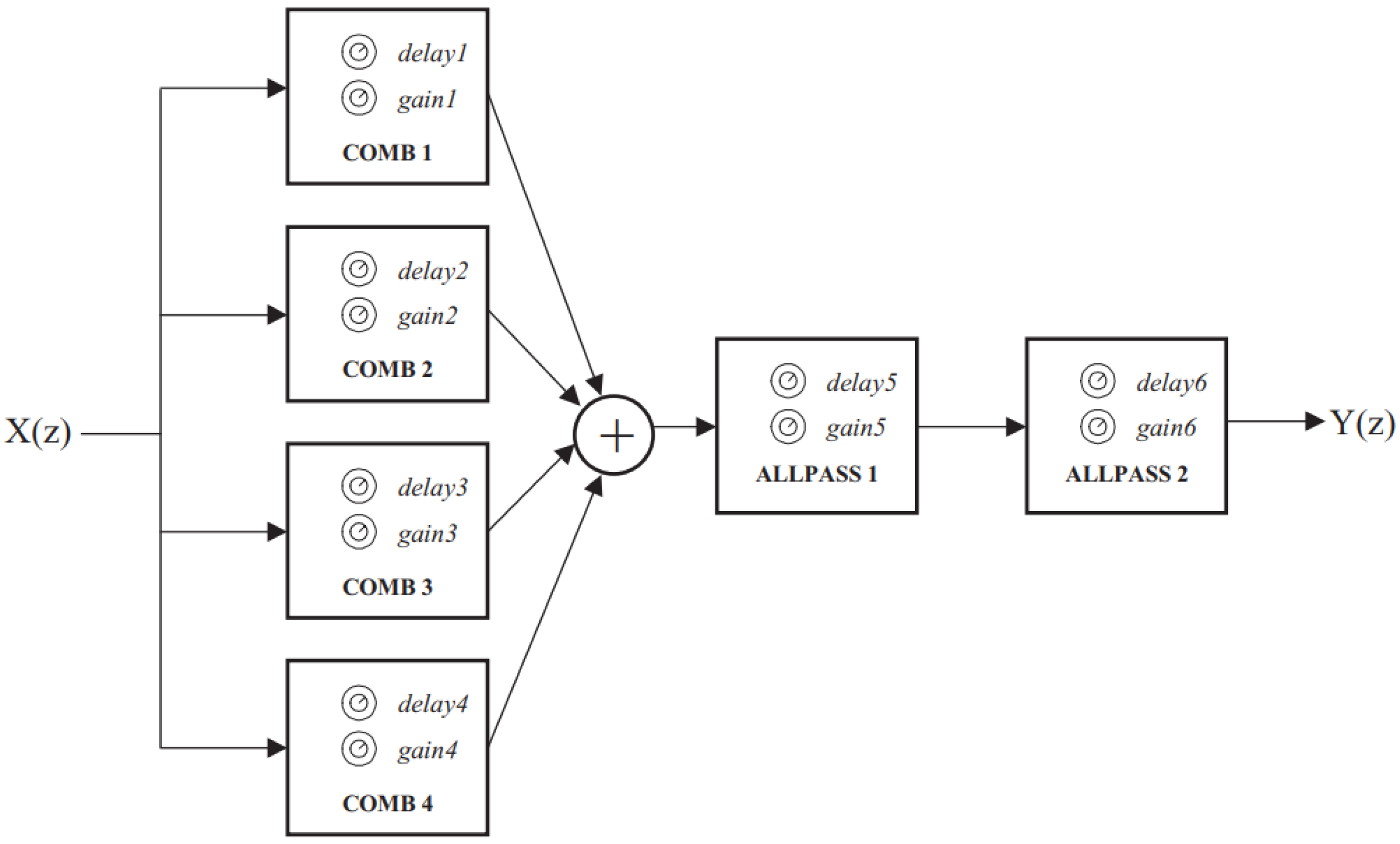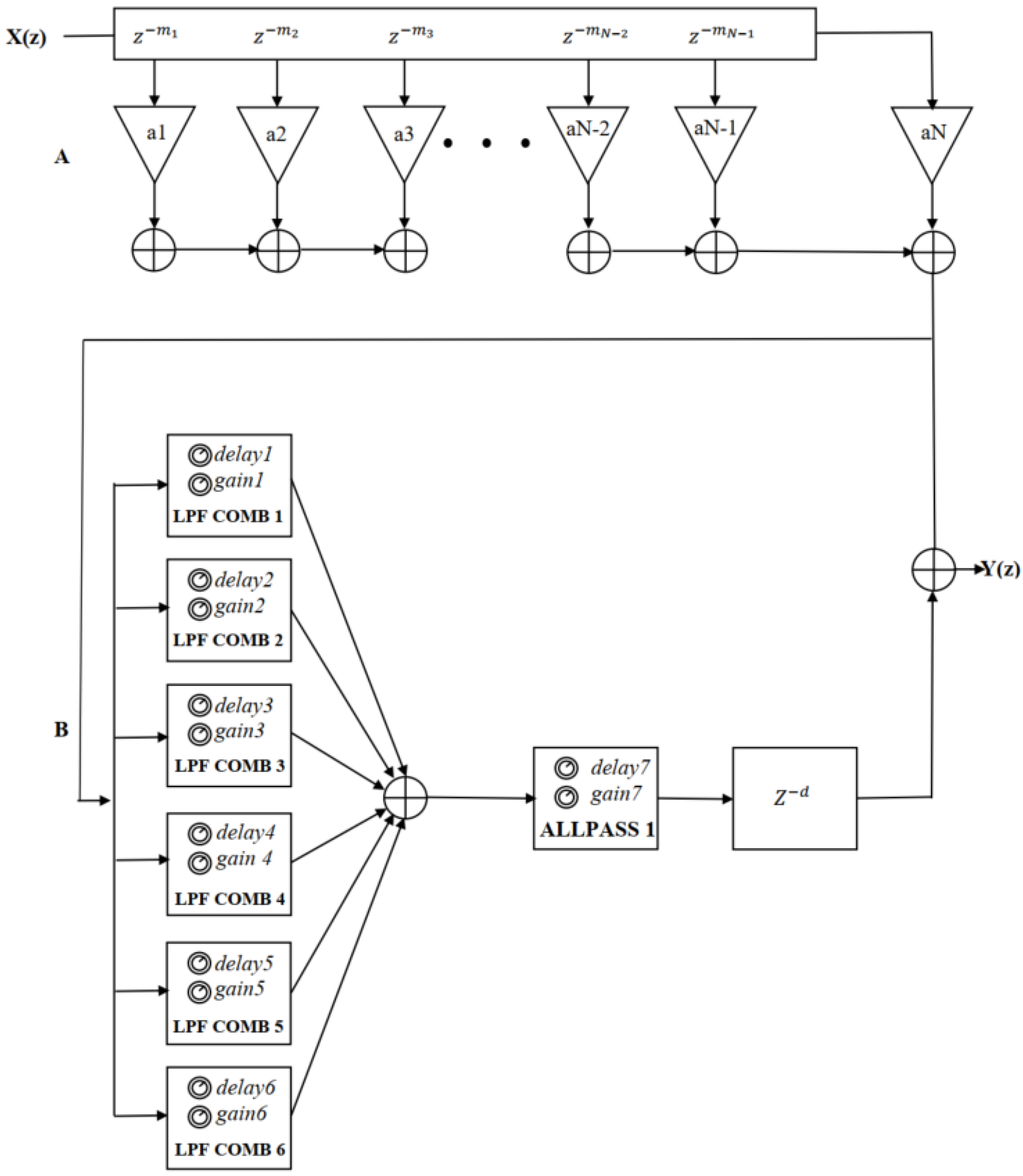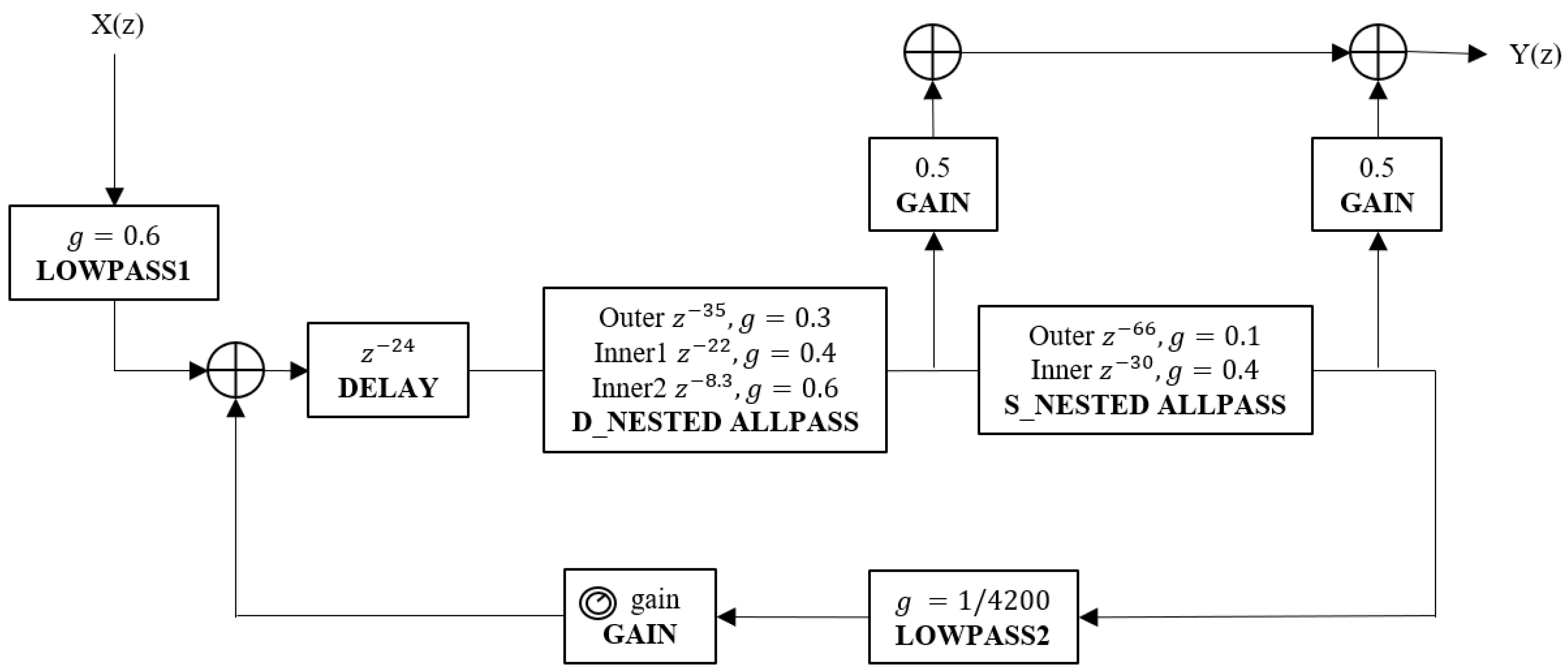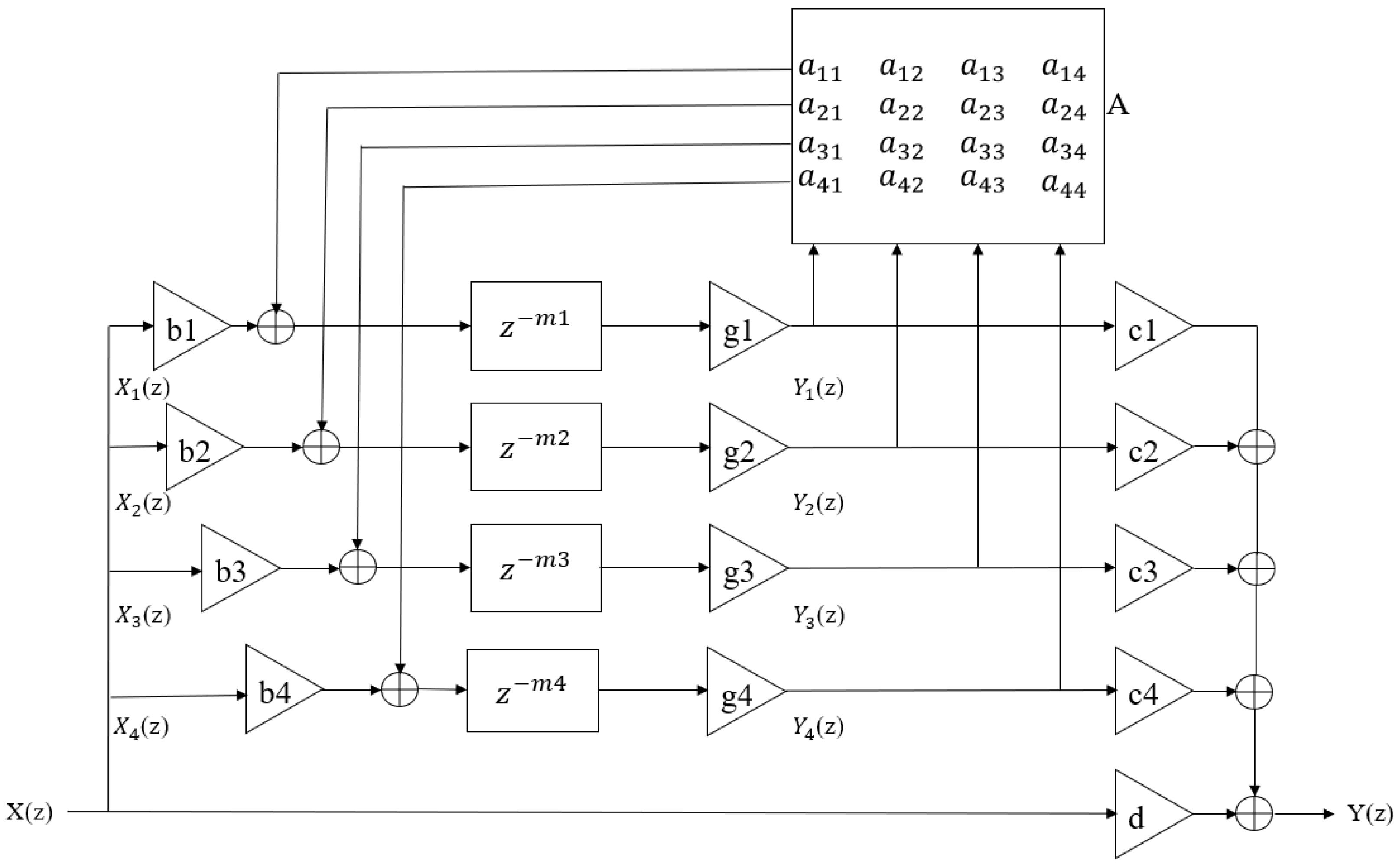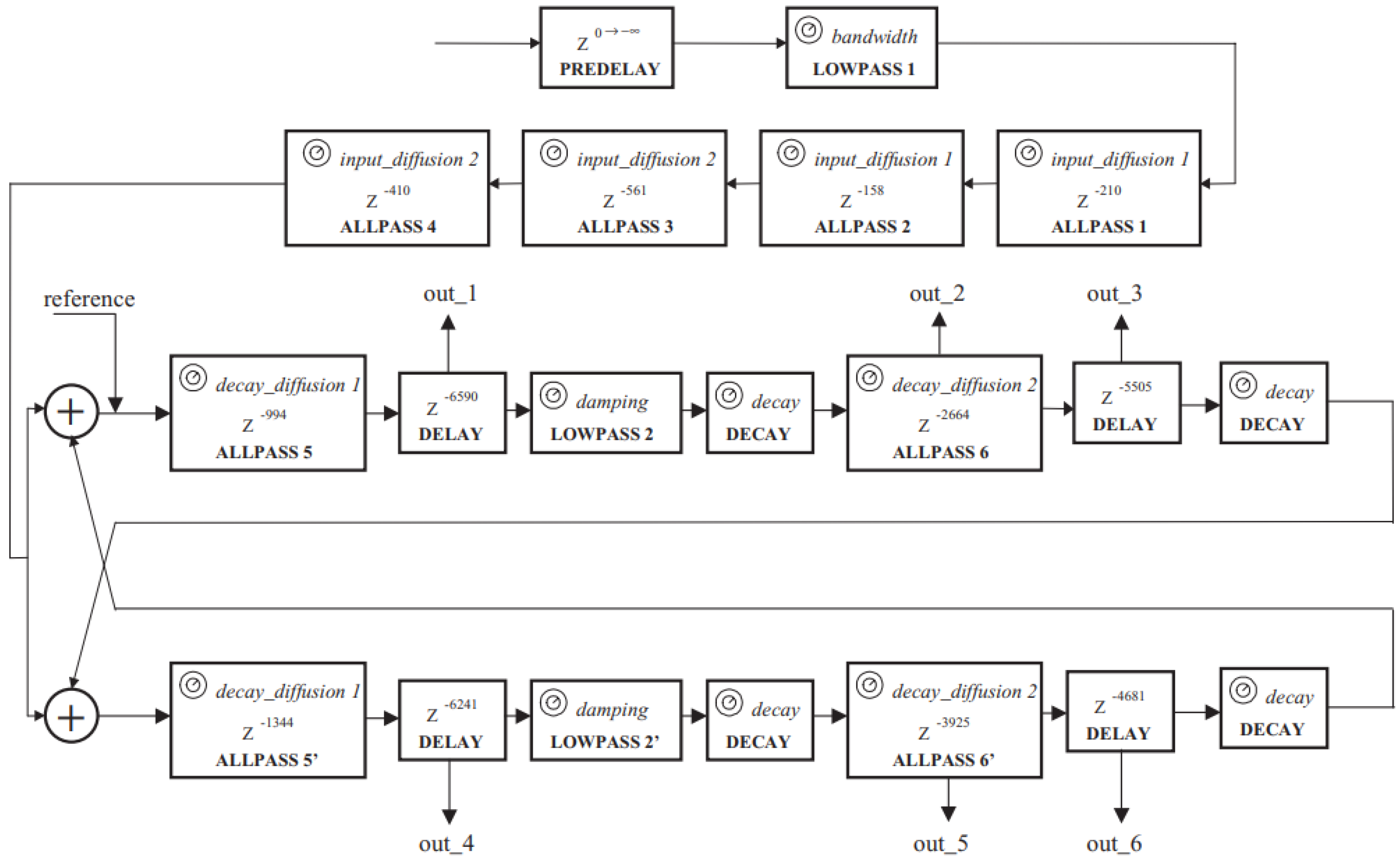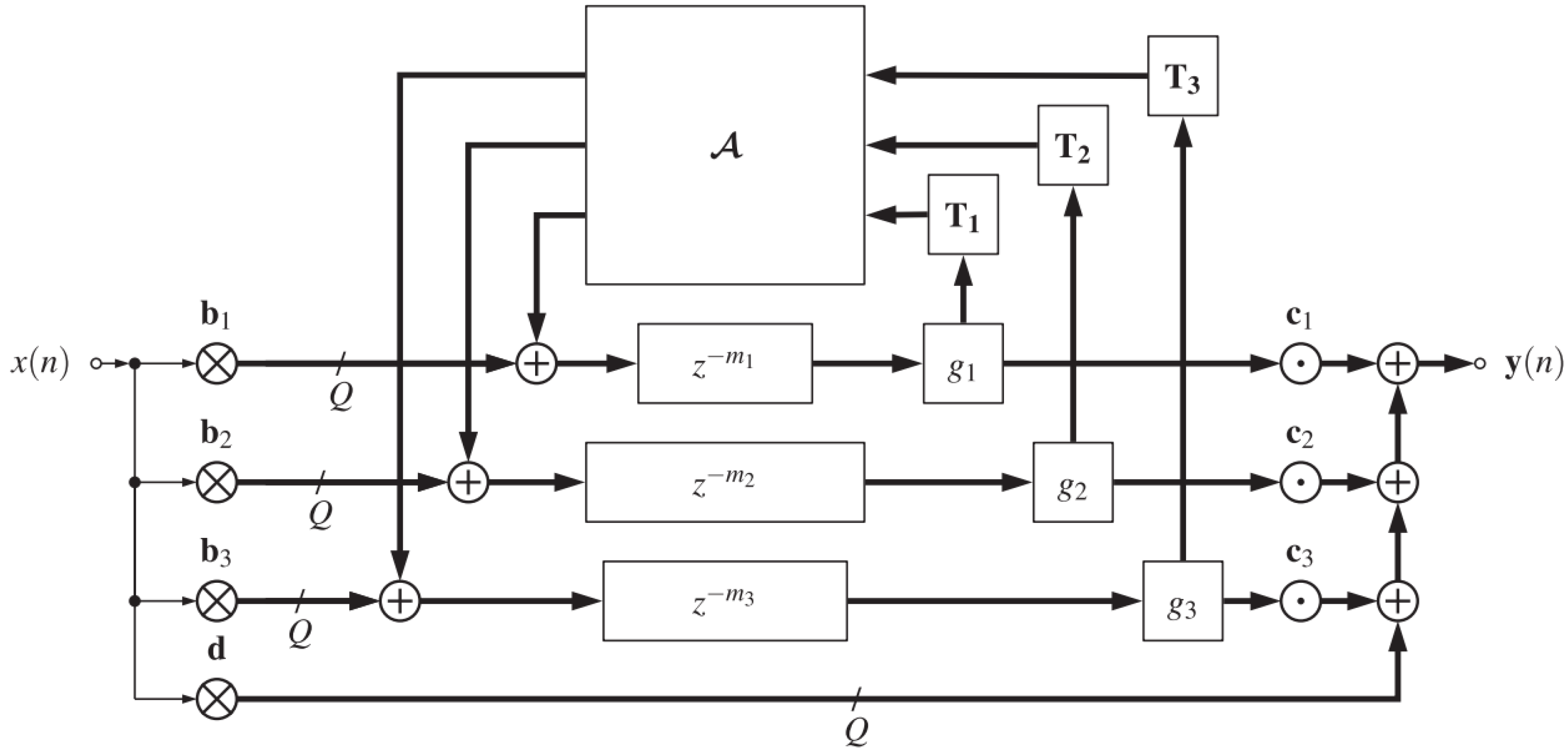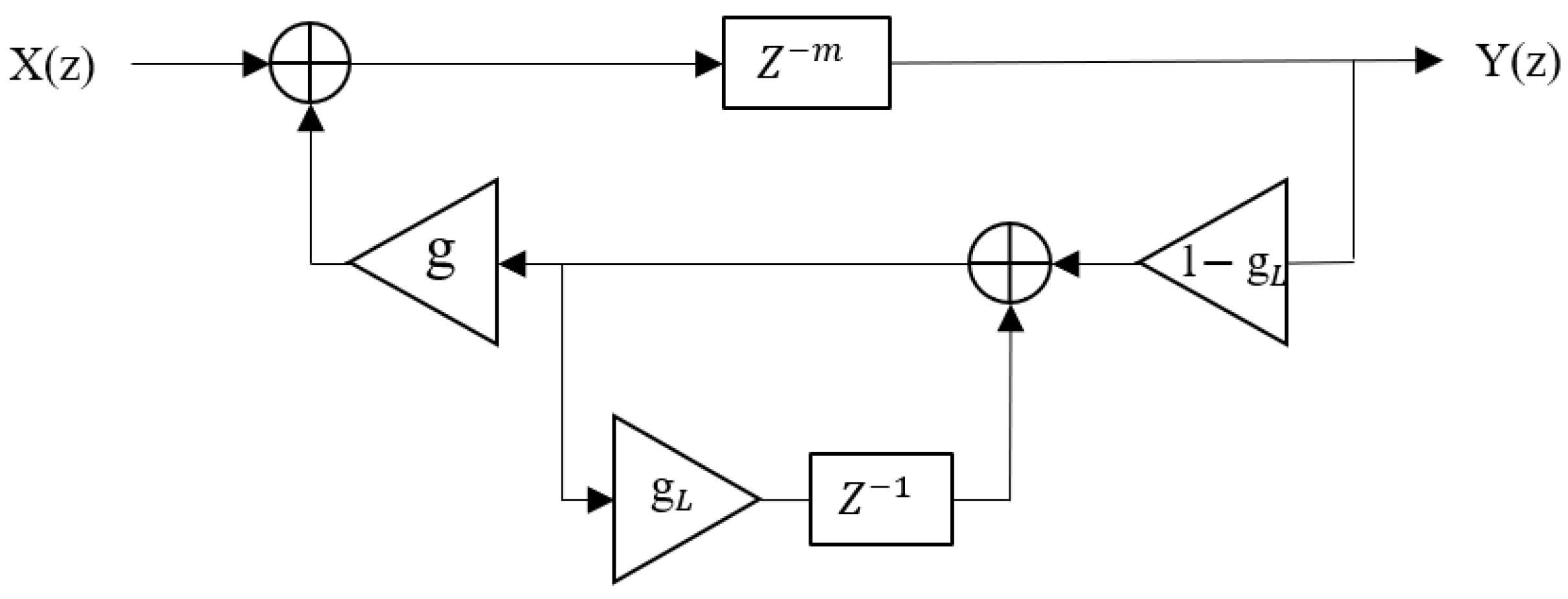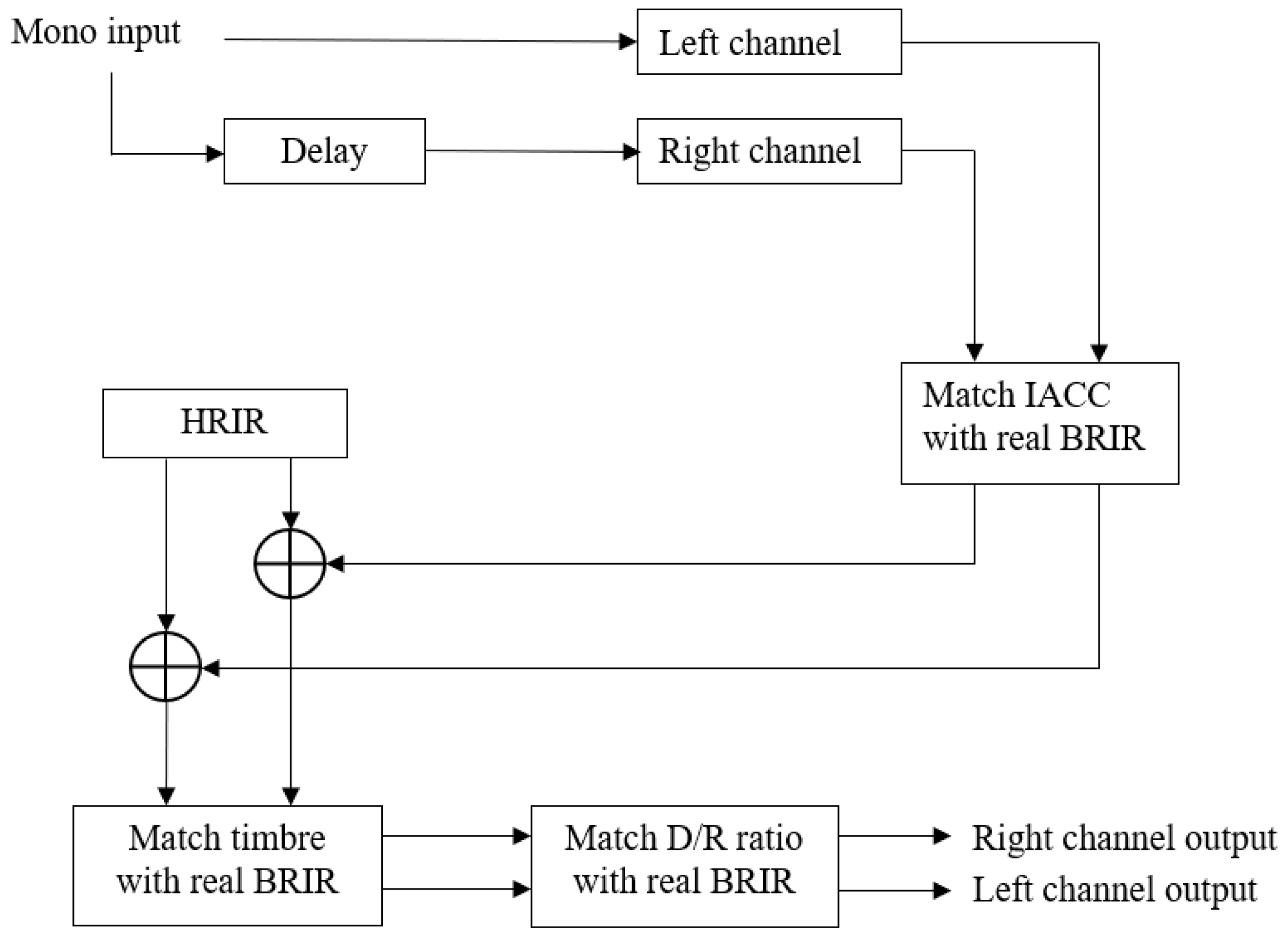2.1. Virtual vs. Real-World Acoustics
In an effort to establish appropriate reference conditions for this study, prior work which has looked at comparing real-world acoustic recordings with virtual acoustic rendering from acoustic measurements is first considered.
Kearney [
12] compared the perceptual differences between actual acoustic recordings and ’virtual’ recordings made through convolution with binaural room impulse responses (BRIRs), which represent the transfer functions between a sound source and the ears as measured in a reverberant space. He assessed the differences between real and virtual violin and female speech recordings on five subjective attributes (source width, reverberance, clarity, naturalness and source movement). It was found that, apart from the source width, which is related to the directional response of the original acoustic source and the measurement loudspeaker, there was no significant difference between actual and virtual recordings in the other attributes [
12]. The virtual acoustic recordings of the violin samples had a smaller source width. For the reverberance attribute, the samples did not differ statistically. For the clarity attribute, in the case of female singing, the virtual recording showed a significant improvement in clarity over the actual recording. For both source types, no variation in source movement was perceived overall. In terms of natural timbre, no significant differences were found between the actual and virtual source recordings.
Blau et al. [
13] compared the various perceptual properties of real and auralised rooms in 2018. Their results showed that when using measured BRIRs, even non-individual BRIRs, highly convincing speech auralisation is possible. Small defects in the simulations can be reliably detected. Blau et al. [
14] later compared the consistency of the auralisation of measurement-based binaural room impulse response with the real source (speech signal) for five attributes (reverberation, source width, source distance, source direction, and overall quality). The results showed that, although the measured BRIR set for ’reverberance’ was rated slightly lower than the other attributes with a median score of around 7 on a nine-point scale, for all other attributes, the agreement with the real room was rated with medians of 7.5 or higher on the nine-point scale based on the measured BRIR. The fact that the measured BRIR sets were capable of eliciting such high ratings suggests that the measured impulse response can be made realistically audible for speech. Therefore, it was concluded that close-to-real binaural auralizations of speech are possible if all modalities (auditory, visual, etc.) are appropriately reproduced [
13]. Others, such as Lokki et al [
15], have evaluated the properties of algorithmic simulations of binaural auralisation in relation to real head recordings. The results show that the spatial properties are almost identical, though there are differences in timbre. However, in general the auralisation algorithm achieves reasonable and natural binaural auralisation.
The perceptual similarity of real and virtual recordings reported in previous work therefore justifies the use of anechoic audio samples rendered with measured binaural room impulse responses as reference conditions to represent the ’real’ recorded reverberation in the current study.
It is important to note that the above experiments were all implemented in a static rendering environment and did not involve head tracking or testing in an augmented reality scenario.
2.2. Reverberation Algorithms for AR Scenarios
It is impractical to apply BRIRs measured in real spaces to AR scenarios, as AR can happen in any environment, requiring a large database of impulse responses to draw from, which is not as easy as manipulating the parameters of an algorithmic reverb [
16]. Furthermore, measuring an impulse response is non-trivial, and multiple measurements are required for real-time interpolation if adaptive dynamic reverberation processing based on any user position is the goal [
12,
17].
There have been many significant efforts as of the time of writing in the application of computational reverberation algorithms for convincing AR.
Harma et al. proposed a technique and application of Wearable AR Audio (WARA) [
18]. The model’s direct sound and 14 early reflections (six first-order and eight lateral planar second-order early reflections) were calculated from a simple shoebox room model with user-adjustable wall, floor, and ceiling positions. To match the length of the reverberation to that of the pseudo-acoustic environment, diffuse late reverberations were added using a variant of a Feedback Delay Network (FDN). The parameters of the reverberation algorithm (e.g. reverberation time) were set manually by analysing the reverberation of the environment or estimating parameters automatically from the binaural microphone signals. The additional information about the user’s orientation and position required for room modelling and binaural synthesis was estimated using a number of head-tracking devices.
A real-time binaural room modeling proposal for AR applications based on Scattering Delay Network (SDN) reverberation was presented by Yeoward, et al. in 2021 [
19]. The combination of Digital Waveguide Network (DWN) and ray-tracing Image Source Method (ISM) approaches for SDN reverberation provides physical accuracy close to room simulation models while meeting the lower processing requirements of other reverberators that use delay networks [
19,
20,
21]. A study by Djordjevic et al. [
22] indicated that SDNs are considered more natural than binaural room impulse responses, ray tracing, and feedback delay networks in evaluations based on non-interactive simulations of two listening rooms. However, the suitability of SDNs for AR applications needs to be determined, as binaural SDN models have not been proposed in real-time architectures suitable for mobile or wearable computing devices [
19].
Because this paper evaluates artificial reverberation algorithms based on delayed networks, SDN reverberation based on digital waveguide networks (DWN) and ray-traced image source models are not included among the studied algorithms. Moreover, the main disadvantage of computational acoustics is that the transfer operators take up a large memory footprint when sound propagates between surfaces, with the result that computational methods encounter a bottleneck [
23,
24].
Conversely, artificial reverberation algorithms based on delay network structures have flexible parameterization characteristics and better real-time performance [
25]. It is useful to examine the output of such algorithms by looking at their response to a discrete unit sample function [
26] passing through various filters and delay lines and feedback connections. This is equivalent to visualization of RIRs, and is readily achieved within the MATLAB environment [
27], which has a rich filter structure database. In addition to recursive filters based on delay networks, simple finite impulse response (FIR) filters can be used to implement early reflection simulations. As a filter with no feedback support, FIR filters can be designed with arbitrary amplitude-frequency characteristics while maintaining strict linear phase characteristics, and are widely used in speech and data transmission [
28]. However, because the filter has no feedback, more coefficients are required in the system equations [
29]. For the purposes of AR, simplicity, real-time performance and computational efficiency must be considered.
In this context, the present paper is devoted to analysing the similarity between reverberation simulated with different delay networks against measured BRIRs.
For plausible AR scenarios, two channel binaural listening needs to be considered [
30]. Binaural reverberation not only encapsulates room effects, it includes the cues for human sound source localisation, that is, inter-aural time and level differences and spectral cues due to the torso, head, and pinnae [
31]. Therefore, the reverberation algorithms mentioned throughout this paper are binaural. In the case of measured reverberation, the BRIRs are impulse responses measured with a binaural dummy head.
2.3. Delay Network Reverberation
The traditional approach to synthesizing reverberation is based on delay networks combining feedforward paths to render early reflections and feedback paths to synthesize late reverberation [
32]. One of the earliest and most famous reverberation algorithms was presented by Schroeder in 1961 [
5]; it has a simple structure consisting of four parallel comb filters and two series all-pass filters, as shown in
Figure 1 [
27]. Natural reverberation consists of random closely-spaced impulse responses of exponentially decaying amplitude [
33]. The first two conditions can be achieved by ensuring that the delay of each comb filter has no common divisor, and exponential decay can be achieved by making their reverberation times equal [
5,
8,
34,
35,
36,
37]. The reverberation time of the comb filters is equal to the overall reverberation time. Therefore, according to Schroeder’s recommendation [
5,
27], the maximum to minimum delay ratio of the four comb filters is approximately 1.5 (especially between 30–45 ms) and the gain of the comb filters are adjusted to obtain the desired reverberation time. The two all-pass filters have delays of approximately 5 ms and 1.7 ms, respectively, and their gains are both adjusted to 0.7. In this study’s implementation of Schroeder reverberation, the reverb time (
) is a user-oriented and adjustable parameter (range 0.1–5 s). The filter delays (
T) are set according to Schroeder’s recommendations [
5,
27], and the filter gains (
g) are calculated from the delay time (
T) and the reverberation time (
) through Equation (
1) [
5]. The parameter values of each filter are presented in
Table 1 [
38].
Moorer enhanced the Schroeder reverberation algorithm in 1979 [
6] through four critical modifications, as shown in
Figure 2 [
39]. The first improvement was a Finite Impulse Response (FIR) delay line inserted in order to simulate the early reflections of the RIR. Another modification was inserting a one-pole low-pass filter into the feedback loop of each comb filter to simulate the absorption of sound by air in order to decrease the reverberation time at high frequencies, making the sound appear more real. Here, this is called the low-pass-feedback (LPF) comb filter. The third improvement was to increase the number of comb filters from four to six in order to obtain higher echo and modal density, especially for longer reverberation times. Finally, Moorer replaced the all-pass filter near the output with a delay filter to ensure that the late reflections arrive at the output a little later than the early reflections. Moorer proposed parameters for all filters in his study [
6]. As in Schroeder’s reverberation algorithm, the random and closely spaced characteristics of pulses can be realized by ensuring that the delay of each comb filter has no common divisor, while the exponential attenuation can be realized by making its reverberation time (
) equal. Here, adjustments have been made to the parameters of the original low-pass comb reverberation filter. As in the Schroeder reverberation algorithm, the filter gain (
g) is calculated from the delay time (
T) and reverb time (
) through Equation (
1). The FIR parameter values are presented in
Table 2 [
6]. The low-pass feedback gain values for all low-pass feedback comb filters are 0.9, and the values of the late reverberation filters are shown in
Table 3 [
6].
Gardner proposed a set of reverberation algorithms aimed at simulating the reverberation effects of different room sizes [
7]. These algorithms share three similar structures for different sizes of room (small, medium, and large) with different reverberation times [
40]. These three reverberator structures are shown in
Figure 3,
Figure 4 and
Figure 5, respectively [
7,
27], and their corresponding reverberation time ranges are presented in
Table 4 [
7]. The structures of these three algorithms mainly include all-pass filters (simple and nested), delay filters, and a first-order low-pass filter. In this study’s implementation of the Gardner reverberation, the delay length of each filter is adjusted somewhat to better match the correct reverberation time. The corresponding parameter values for each filter are presented in
Table 5 [
7].
Feedback Delay Network (FDN) was proposed by Jot in 1992 [
8]. It consists of N-dimensional delay lines and a feedback matrix, as shown in
Figure 6 [
10,
27,
41]. As a novel and versatile reverberator design structure, it provides separate and independent control of the energy storage, damping, and diffusion components of the reverberator [
42]. Compared with parallel comb filters, this feedback structure can generate much higher echo density given a sufficient number of non-zero feedback coefficients and delay lengths [
41]. In this paper, we adopt four-dimensional delay lines. In this structure, following Schroeder’s advice [
5], the delay length (
) of each delay line is derived from a prime power exponential delay Equations (
2) to (
5). The gain (
) for each delay line is calculated from a given reverberation time (
) and sample rate (
) by Equations (
6) to (
8) according to Alary’s [
10] suggestion. The feedback matrix (
A) is implemented by a fourth-order Hadamard matrix. The input gain (
), output gain (
), and direct sound gain (
d) are all set as 1 in this structure, and can be adjusted as required. The total minimum delay length
is defined as
where
indicates plus one for rounding;
is the preliminary estimate of the non-prime-number delay length for each delay line, and is expressed as
is the index of the position of the prime number to be drawn from the set of prime numbers, given by
where prime
is 2, 3, 5, 7, 11, etc., means rounding to the nearest whole number, and
is the delay of each delay line, which is a power of a distinct prime provided by
is a per-sample attenuation gain,
is a linear scale gain converted from a logarithmic scale gain, and
is the target gain of each delay line, given respectively as
Dattorro published a topology structure for a reverberation algorithm in 1997 [
9]. The implementation of this reverberation structure is composed of a pre-delay followed by a low-pass filter, a decorrelation stage, and a ‘tank implementation’, as shown in
Figure 7 [
27]. The decorrelation stage includes four cascaded all-pass filters which can perform a rapid build-up of echo density. The decorrelation stage does not have a feedback loop, and as such is straightforward; however, the ‘tank’ is more complex because of its recursive structure [
27]. The ‘tank implementation’ consists of two cross-coupled symmetrical lines, which cause the infinite recirculation of the input signal. Each line contains two all-pass filters, two delays, a low-pass filter, and two decay coefficients for attenuation. These decay coefficients help to control the reverberation time. The input signal passes through these filtering structures accordingly, and the network produces a final decorrelated all-wet stereo output by summing up six output signals extracted from the ‘tank implementation’ [
27]. The delay length is marked in
Figure 7 [
27]; the delay of the pre-delay is 0.001 s, the decay is derived from a given reverberation time (
) and sample rate (
) by Equations (
9) to (
12), and the other parameters used in this structure are presented in
Table 6 [
27]. In addition, the delays and signs used to generate the output of Dattoro’s reverberator are provided in
Table 7 [
27].
Alary designed a new reverberation algorithm named the Directional Feedback Delay Network (DFDN) in 2019, which is shown in
Figure 8 [
10]. The DFDN is an extension of a conventional FDN, which can produce direction-dependent reverberation times and control the energy decay of a reverberant sound field, which is suitable for anisotropic decay reproduction on a loudspeaker array or in binaural playback through the use of Ambisonics [
10]. Considering computational cost, the higher the order of the Ambisonics, the longer the running time. When comparing the computational cost with a traditional FDN, the cost of the DFDN increases by a factor equal to the number of channels in the delay line group. For example, a four delay-line DFDN using third-order Ambisonics was adopted by Alary [
10]; thus, his reverberator has four groups of sixteen delay lines, making for a total of 64 delay lines. Therefore, the number of delay lines increases by a factor of 16 when compared to an equivalent conventional FDN. However, the DFDN used in this paper adopts four delay lines using first-order Ambisonics in order to reduce computational costs. First-order Ambisonics includes four channels, meaning that the reverberator has four groups of four delay lines, making for a total of sixteen delay lines, which decreases the number of delay lines by a factor of four compared to an equivalent third-order Ambisonics DFDN. The parameters and simulation of this reverberation algorithm can be found in Alary’s research [
10].
